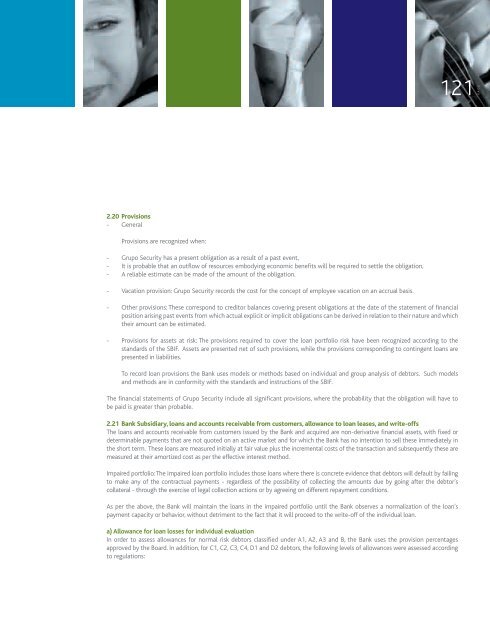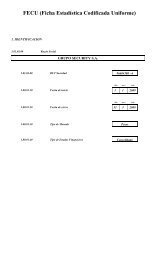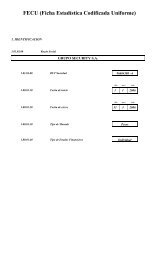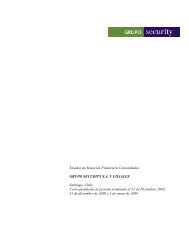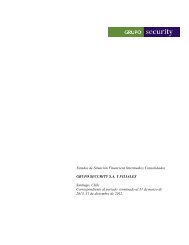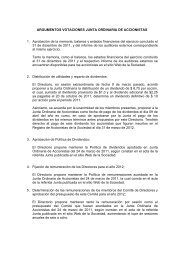PA - Banco Security
PA - Banco Security
PA - Banco Security
Create successful ePaper yourself
Turn your PDF publications into a flip-book with our unique Google optimized e-Paper software.
121<br />
<strong>PA</strong>GE<br />
2.20 Provisions<br />
- General<br />
Provisions are recognized when:<br />
- Grupo <strong>Security</strong> has a present obligation as a result of a past event,<br />
- It is probable that an outflow of resources embodying economic benefits will be required to settle the obligation,<br />
- A reliable estimate can be made of the amount of the obligation.<br />
- Vacation provision: Grupo <strong>Security</strong> records the cost for the concept of employee vacation on an accrual basis.<br />
- Other provisions: These correspond to creditor balances covering present obligations at the date of the statement of financial<br />
position arising past events from which actual explicit or implicit obligations can be derived in relation to their nature and which<br />
their amount can be estimated.<br />
- Provisions for assets at risk: The provisions required to cover the loan portfolio risk have been recognized according to the<br />
standards of the SBIF. Assets are presented net of such provisions, while the provisions corresponding to contingent loans are<br />
presented in liabilities.<br />
To record loan provisions the Bank uses models or methods based on individual and group analysis of debtors. Such models<br />
and methods are in conformity with the standards and instructions of the SBIF.<br />
The financial statements of Grupo <strong>Security</strong> include all significant provisions, where the probability that the obligation will have to<br />
be paid is greater than probable.<br />
2.21 Bank Subsidiary, loans and accounts receivable from customers, allowance to loan leases, and write-offs<br />
The loans and accounts receivable from customers issued by the Bank and acquired are non-derivative financial assets, with fixed or<br />
determinable payments that are not quoted on an active market and for which the Bank has no intention to sell these immediately in<br />
the short term. These loans are measured initially at fair value plus the incremental costs of the transaction and subsequently these are<br />
measured at their amortized cost as per the effective interest method.<br />
Impaired portfolio: The impaired loan portfolio includes those loans where there is concrete evidence that debtors will default by failing<br />
to make any of the contractual payments - regardless of the possibility of collecting the amounts due by going after the debtor’s<br />
collateral - through the exercise of legal collection actions or by agreeing on different repayment conditions.<br />
As per the above, the Bank will maintain the loans in the impaired portfolio until the Bank observes a normalization of the loan’s<br />
payment capacity or behavior, without detriment to the fact that it will proceed to the write-off of the individual loan.<br />
a) Allowance for loan losses for individual evaluation<br />
In order to assess allowances for normal risk debtors classified under A1, A2, A3 and B, the Bank uses the provision percentages<br />
approved by the Board. In addition, for C1, C2, C3, C4, D1 and D2 debtors, the following levels of allowances were assessed according<br />
to regulations:


